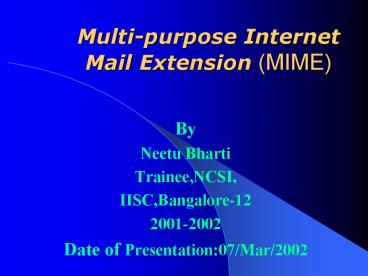Multipurpose Internet Mail Extension MIME - PowerPoint PPT Presentation
1 / 18
Title:
Multipurpose Internet Mail Extension MIME
Description:
'MIME, stand for Multi-purpose Internet mail Extensions, is a ... Quoted-printable is for text-only messages. A few others. 7bit No encoding Case insensitive ... – PowerPoint PPT presentation
Number of Views:2912
Avg rating:1.0/5.0
Title: Multipurpose Internet Mail Extension MIME
1
Multi-purpose Internet Mail Extension (MIME)
- By
- Neetu Bharti
- Trainee,NCSI,
- IISC,Bangalore-12
- 2001-2002
- Date of Presentation07/Mar/2002
2
Contents
- Definition of MIME
- Introduction
- What exactly is MIME?
- How it Works?
- MIME-Specific Technical Definitions
- Example of MIME
- Summary
3
Definition of MIME
- MIME, stand for Multi-purpose Internet mail
Extensions, is a freely available specification
that offers a way to interchange text in
languages with different character sets, and
multimedia e-mail among many different computer
system that use Internet mail standards.
4
Introduction
- MIME extends the format of Internet mail to allow
non-US-ASCII textual messages, non-textual
messages, multipart message bodies, and
non-US-ASCII information in message headers. - MIME provides Internet mail users with
functionality similar to that of MS-Mail for
LAN-based internal mail. MS-Mail and MIME allow
the attachment of files and other objects, as
does MIME. Unfortunately, Microsofts method of
handling these attachments is undertaken through
a proprietary format and MS-Mail does not provide
compliance with the MIME open standard.
5
Cont
- Internet messages with MIME attachments send to
MS-Mail will transfer the appropriate text
portions of the message, but MS-Mail will
generally forward the attachments as encoded
text, which may then be saved to a file and
decoded. Conversely, messages sent from MS-Mail
with attachments to an Internet MIME mail system
will transfer the text portions and send the
attachments as encoding text, but use a different
method of encoding from the used by MIME and
without the information needed for processing the
message attachment by the recipient. Email
messages arriving at the National Library with
MIME attachments are likely to be corrupted.
6
What exactly is MIME?
- In 1992, a new standard was defined by an
Internet engineering task force working group in
RFC1521 1522 called MIME. - MIME is an extension to the Internet mail
standard, known as Simple Mail Transfer Protocol
(SMTP) that allows mail messages containing
different type of multimedia information to be
sent across the network this includes, but is not
limited to, word-processor documents,
spreadsheets, programs, graphics, audio, and
motion picture files, as well as links that
enable users to retrieve information from remote
databases from within a mail message.
7
Cont
- MIME is a specification for enhancing the
capabilities of standard Internet e-mail. - It offers a simple standardized way to represent
and encode a wide variety of media types of
transmission via Internet mail. - It is defines extensions to SMTP to support
binary attachments of arbitrary format. - The designers of MIME have learned a lot from the
old SMTP protocol and its mailers. - MIME is here to stay and it works.
8
Cont
- When using the MIME standard, messages can
contain the following types - Text message in US-ASCII
- Character set other than US-ASCII
- Multiple objects in a single messages
- Multimedia Image, Audio, and Video messages
- Multi-front messages
- Messages of unlimited length
- Binary files
9
Cont
- MIME is defined to be completely backwards
compatible, yet flexible and open to extensions.
Therefore, it builds on the older standard by
defining additional fields for the mail message
header, that describes new content types, and a
distinct organization of the message body.
10
How MIME works?
- The developers of MIME found a clever way to work
around the limitation. It packages different data
types into a 7-bit ASCII format. that way, all
e-mail, regardless of the data it contains,
appears as standard e-mail messages to the
internets SMTP servers. The beauty of the
solution lies in the fact that SMTP didnt have
to change to handle such data.
11
Cont
- Uses a new binary encoding scheme called BASE 64
- New SMTP headers describe the attached document
- User agents read the header to figure out how to
interpret the message
12
MIME Specific technical definition
- New MIME headers
- The Content-type headers
- The Application-type headers
- The Content-transfer-Encoding
- The Content-ID Content Description
- Multipart Message
- Non-ASCII text in mail messages
13
New MIME headers
- Required fields
- MIME - Version
- Date - Time
- Optional fields
- Content- type
- Content-transfer_encoding
- Content-ID
- Content-description
- Content-disposition
14
The Content-type Header
- Content-type sub-type describes what format this
part of the message is in - Text Image
- Message Audio
- Application Video
- Multipart
- The default type is simple ASCII text
- MIME-Version 1.0
- Content-typetext/plaincharsetUS-ascii
15
The Content-type Applications
- Subtypes
- Postscript
- Octet-Stream-Unidentified binary data
- Many other will be added
16
The Content-transfer-Encoding
- Base64 encoding algorithm is used to encode
binary data in 7bit ASCII data - Quoted-printable is for text-only messages
- A few others
- 7bit No encoding
Case insensitive - 8bit No encoding
- Binary No encoding
- X-token No encoding
- Example
17
Summary
- MIME has been designed to avoid problems caused
by additional restrictions imposed by some
Internet mail transport mechanisms. - The Multipart and Message content types allow
mixing and hierarchical structuring of objects of
different types in a single message. Further
content types provide a mechanism for tagging
messages or body parts as audio, image, or other
kinds of data. - Finally, a number of useful content types are
defined for general use by consenting user
agents, notably Text/Richtext, Message/Partial,
and Message/External-Body.
18
Thank You.































